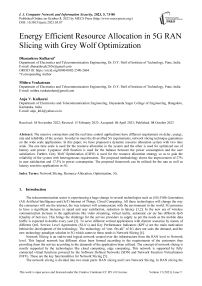Energy Efficient Resource Allocation in 5G RAN Slicing with Grey Wolf Optimization
Автор: Dhanashree Kulkarni, Mithra Venkatesan, Anju V. Kulkarni
Журнал: International Journal of Computer Network and Information Security @ijcnis
Статья в выпуске: 5 vol.15, 2023 года.
Бесплатный доступ
The massive connections and the real time control applications have different requirement on delay, energy, rate and reliability of the system. In order to meet the diversified 5G requirements, network slicing technique guarantees on the wide scale applications. In this paper, we have proposed a dynamic resource allocation system with two time scale. The one time scale is used for the resource allocation in the system and the other is used for optimized use of latency and power. Lyapunov drift function is used for the balance between the power consumption and the user satisfaction. Further, Grey Wolf Optimization (GWO) is used for the resource allocation strategy so as to gain the reliability of the system with heterogeneous requirements. The proposed methodology shows the improvement of 27% in user satisfaction and 17.5% in power consumption. The proposed framework can be utilized for the rate as well as latency sensitive applications in 5G.
Network Slicing, Resource Allocation, Optimization, 5G
Короткий адрес: https://sciup.org/15018646
IDR: 15018646 | DOI: 10.5815/ijcnis.2023.05.07
Текст научной статьи Energy Efficient Resource Allocation in 5G RAN Slicing with Grey Wolf Optimization
The telecommunication sector is experiencing a huge change in several technologies such as (5G) Fifth Generation, (AI) Artificial Intelligence and (IoT) Internet of Things, Cloud Computing. All these technologies will change the way the consumers will use the internet, the way internet will communicate with the environment in the world. 5G promises to have a significant increase in speed and user satisfaction, reduction in latency [1,2]. In the new era of wireless communication increase in the applications like video streaming, virtual reality, automatic car etc has different QoS (Quality of Service). This brings the challenge for the service providers to supply as per the needs as the mobile data traffic is expected to double every year [3]. To serve different vertical applications with distinct scenarios by means of different QoS, Service Level Agreements (SLA’s) and Key Performance Indicators (KPI’s) are the main motivation behind the development of the technology. The technology of “one- fits-all” of 4G does not suits the demand, and the new technology paradigm solution in 5G which caters to these needs is Network Slicing [4].
Network Slicing is an end-to-end logical network created over the infrastructure from the RAN level to Network level. This logical network has different slices been formed according to the requirements of the customers thus providing them the service according to the demands of the application been utilized. The concept of network slicing is mostly supported by the technologies like cloud computing, edge computing. This network is supported by fully connected virtual functions powered by the Software Defined Networks (SDN) and Network Function Virtualization (NFV). These are the key functionalities for Network Slicing [5].
The network slicing is divided into two main parts: RAN slicing and Core Network Slicing. In RAN slicing the computation, sharing of resources, resource allocation are the main challenges whereas in core network slicing isolation and management of the end to end slicing is challenging. The end to end slicing also includes the transport network as the link between the RAN and the core [6]. This network slicing technique in 5G brings various promising solutions to various scenarios but it also results in inhere challenges like decreased energy efficiency and spectral efficiency. Hence, there is a growing need to have energy efficient schemes for energy management in network slicing. In view of this, the work has been carried out on the thrust area of energy efficient optimizing algorithms resource allocation schemes in RAN slicing based 5G system. The emerging approaches in IoT devices, high data rate wireless services and the low latency devices which are all focusing on the QoS demands like bandwidth demands for the resources from the resource blocks [7]. Since, these resources are very limited optimized resource allocation scheme plays an important role in the RAN slicing 5G system. In this context, there are some recent related works on optimum resource allocation with energy efficiency.
2. Related Works
There are several issues that are important for topology developing; First of all, it is fault tolerance ensuring. Modern high-performance systems are a large (up to millions of nodes and billions of cores), so, the failure rate is very high. Another important issue is the routing. Ease of routing directly affects the effectiveness of message transmission. Commonly used methods, such as tabular routing, are optimal for systems with a dynamic topology, but they are not a good choice for the static-structured system.
In the scope of the rapid deployment of all the devices in the 5G system, the energy efficiency depends on the usage pattern and is measured as the electrical energy spent per transmitted data volume over a period of time in Joules/bit [8]. The increasing energy efficiency can be grouped in various categories such as network planning and deployment [9] energy harvesting and transfer [10] resource allocation [11] and hardware solutions [12, 13]. Among the above mentioned resource allocation schemes is a major governing factor and hence is the focus of work in this paper. Kourtis et al. [14] have worked with the emergency respondents where the area of focus has been on funding the average energy consumption, achieved through numerology manipulations, variations in the slot period and change in the scheduling time on the Katana infrastructure. Unlike in [14] B. Matthiesen et al. [15] have considered the SDN and NFV as the base of the infrastructure. A joint bandwidth and power allocation algorithms is designed under the heterogeneous requirements. This multi-objective optimization problem works when the QoS constraint occurs. The algorithm first fulfils the requirements and then allocates the remaining resources to the slice. S. Ravindran et al. [7] have considered heterogeneous requirements for experimentation. In [15] authors have also used heterogeneous requirements, but they have also worked on the multi-sub-slice connected UE where the slice is such designed that it is dedicated to the particular application. The authors have modeled an energy efficient system resource allocation model to gain better throughput with improved energy efficiency. H. Wang [16] has proposed a delay aware resource sharing scheme for RAN through dynamic queue to analyze the average delay of data. J. Kwak [17] has used dynamic resource allocation for heterogeneous requirements. The algorithm proposes the power allocation scheme as “Bandwidth Slicing and Resource Allocation” (BSRA). However, it gives less performance for the uRLLC devices. In [17] and [18] the authors have extended the work of dynamic resource allocation by lyapunov optimization.
Based on the literature review of the above papers the main limitation observed is with respect to the dynamic resource allocation for eMBB throughput and uRLLC latency services. Since, the latency parameter is the important parameter for the uRLLC type devices it should be considered while the creation of the slice. Hence, in this paper the main focus has been on the dynamic resource allocation for eMBB and uRLLC devices.
The major gaps identified which have been the motivation for work are as follows:
-
• The slices created in all the above work did not consider latency parameter while creation of the slices.
-
• Though, the above literature has used some optimization techniques but the Grey Wolf Optimization (GWO) technique has not been explored for resource allocation schemes with RAN Slicing.
The major contributions of this proposed work are as follows:
• Consideration of latency as an important parameter while creating the slice.
• Implementation of lyapunov optimization with heuristic algorithm i.e. GWO for optimum resource allocation.
• Balancing of user satisfaction and energy efficiency using Lyapunov optimization technique
• Establishment of improved reliability through latency parameter of the designed model.
3. System Model
The reminder of this paper is as follows: Section 3 of our work describes about the mathematical modeling of the proposed work. In Section 4, the proposed algorithms are shown for user satisfaction and power allocation. Further in Section 5 the results are discussed and validated using the proposed algorithm. Conclusion and future work are described in Section 6.
In the scenario considered, two types of service requirements to be fulfilled the eMBB (Enhanced Mobile Broadband) and uRLLC (Ultra Reliable Low Latency). The users under eMBB require high data rate whereas the services for uRLLC require very low latency. The below fig.1 shows the system model where number of users, bandwidth allocation, data generated by the users and a control variable (V) are considered as input for resource allocation to the user service request. Control variable (V) which is used to achieve the balance between the two parameters. Since the resources available should be used in very optimize manner, GWO is used to optimize the allocation of resources with satisfying data rate and latency for the eMBB and uRLLC services respectively.
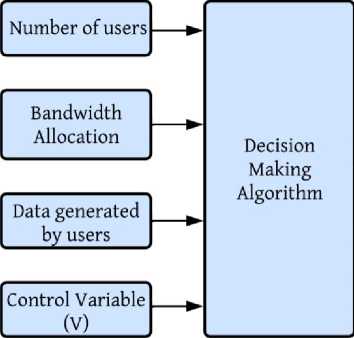
Fig.1. System Model for Resource Allocation and Optimization
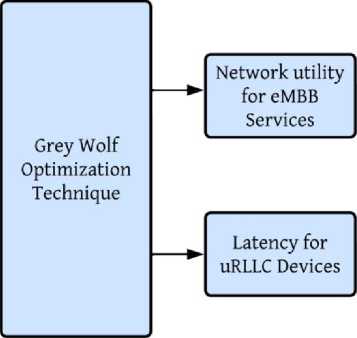
In the literature there are several examples where GWO is used with the 5G technology for antenna design [19], path planning in the network [20], routing and clustering [21]. However, usage of GWO in RAN slicing has been an unexplored terrain in literature. Hence, considering the potential advantages of GWO, the work in this paper has been proposed with GWO as the optimization to be used along the Ran Slicing technique. GWO is a meta-heuristic nature inspired algorithm motivated by the grey wolves [22]. This belongs to the swarm intelligence family algorithms. The main characteristic of the algorithm is to preserve the information about the space, search space from the current iteration to the next iteration with smaller number of steps. In GWO there are four search agents α (alpha), β (beta), δ (delta), ɷ (omega). Alpha is the prime search agent which gives the best position of the prey to hunt. Then the second best is β (beta) and third best is δ (delta) and the remaining solutions are ɷ (omega). Equation 1, 2 and 3 defines the mathematical expression of the algorithm for the hunting process of the prey.
--> . ——> ----> ?
---Z^ . — > ± ?
VS = |C32.W5- Wl
-----—» . > ——:—7» ?
--------> .------^ —-----7» -----Z?
W2 = |WP-C21. VP |
-------> .-----Z^ —--7» Z—?
W3 = |WS -C31. VS l
W (t + 1) =
—>. —> _ —> _
W1+W2+W3
Dynamic resource allocation framework has been considered in the proposed system for heterogeneous requirements. uRLLC devices (U d ), eMBB devices as (E d ) and total number of users (T) are given as,
T = U d + E d
Here, two time – scale have been used; long time scale (L t ) and short time scale (S t ). The resource allocation to the services is done in Lt whereas service control is done at S t . System updates the slicing and resource allocation strategy at each time slot. The bandwidth is given by BW. The bandwidth resource allocated to uRLLC is given by BWU and for eMBB as BWE.
SW = |BWV| + |BWE|
The transmission rate for the uRLLC services (TRu) is given by equation 6. In this framework the system with the concept of Queue has been considered. The queue backlog shows the data generated and data transmitted in each time slot. The allotment of resources is signified in the form of binary matrix. If the resources are allocated then it is denoted as 1 else denoted as 0 for eMBB (B e ) and uRLLC (B u ). The sub-channels are denoted by (C) and allocated sub-channels for uRLLC devices as C u(t) and eMBB devices as C e(t) .
TRuW = Bu№. C^** { loy2[1 + CDu(t)J - V}(6)
|L|
TR.. = Cep t * ^ { log2 [1 + CDe(t) ](7)
Where, CD u(t) is the channel gain noise-to-ratio for uRLLC services and CD e(t) for eMBB services. Ψ is defined as the reliability factor. The transmit power can be calculated from the equation 6 and 7 for uRLLC services and eMBB services respectively. For each time slot the data is generated and the traffic is raised by the devices. With the time the queue length of the system will also increase which in turn increases the latency. The uRLLC services have latency constraints and eMBB services have more throughput constraints so the maximum queue length should not me more than the maximum latency threshold. In the proposed framework, considered maximum threshold of latency is 1.2ms.
The amount of data generated D g(t) and transmitted D z(t) by the device d and the queue backlog of uRLLC devices is Q u(t) and for eMBB devices it is Q e(t) . The updated queue for the next time slot t+1 is given by Q u (t+1) and Q e (t+1) for uRLLC and eMBB devices. Equation 8 and 9 shows the queue backlog for the (t+1) time slot of uRLLC and eMBB devices.
QM(t+1) = [max (QM (t) - DzW , 0) + Dgto] (8)
Qe(t+1) = [max (QeM - DzM, 0) + DgtoA (9)
Further, has been used the Lyapunov drift function to maintain the balance between the two time scales [23] to obtain the user satisfaction with low latency and the data throughput required by the user. The lyapunov drift function is given by the equation 10. To extend this lyapunov drift function in the system for power calculation, equation 11 is designed as to take the decision of the system to compute the power consumption or user satisfaction with a control variable (V). This control variable is used as the lyapunov penalty function (Ki) and is given as,
Ut)= 2{Z de U d O 2(t)+ Z de U d ^ (t) } (10)
Kim = At(L(t) + y{Z t=+,t-1 C(t)Q(t)} (11)
For the bandwidth allocation to the devices, the fig.2 depicts the flowchart describes the complete system. In this, we have considered random input services for the simulation purpose then using these inputs for calculating the lyapunov drift function. This function is further compared with the stability factor (S) which is assumed to be the normal operation of the system. If the (lyapunov penalty function) K i(t) < S; then the system focuses on the computing power consumption with increase in the Power for uRLLC and decrease in the quality for eMBB. The minimum bandwidth is allocated to the uRLLC and the remaining bandwidth is allocated to the eMBB services. If K i(t) > S; then decrease in power consumption for uRLLC and reduce the quality for eMBB. Here the minimum bandwidth requirement is allocated to the eMBB services and the remaining bandwidth from the total bandwidth is allocated to the uRLLC services. Before the allocation of the bandwidth to the services the proposed Dynamic Resource Allocation with GWO (DRA-GWO) is utilized so as to allocate the resources with the help of the search agents α, β and δ. According to the grey wolf optimization α is the most dominant wolf, hence for the purpose of this experimentation α is considered to give the optimized results for the allocation of resources with increase in the user satisfaction as compared to the DRA [18] as well as decrease in the power consumption for uRLLC devices.
4. Result and Discussion
Table 1 shows the system considerations where total 30 devices have been considered with uRLLC devices = 15 and eMBB devices = 15. For the purpose of experimentation, considered control variable is 0.1 and stability factor of uRLLC as 1 Mbps and eMBB as 3.5 Mbps. Fig.3 shows the improved results for the power consumption for uRLLC devices, in this experimentation we the V value has been varied in the range of 3 to 8 and gained the results as shown in the figure. The value of power consumption for the value of V less than 3 is constant 1W and above 8 is constant. Compared to DRA; DRA-GWO gives power consumption as 1 W at V value = 3 and 0.02W at V value =0.02W. We could gain 17.5% improvement in the power consumption.
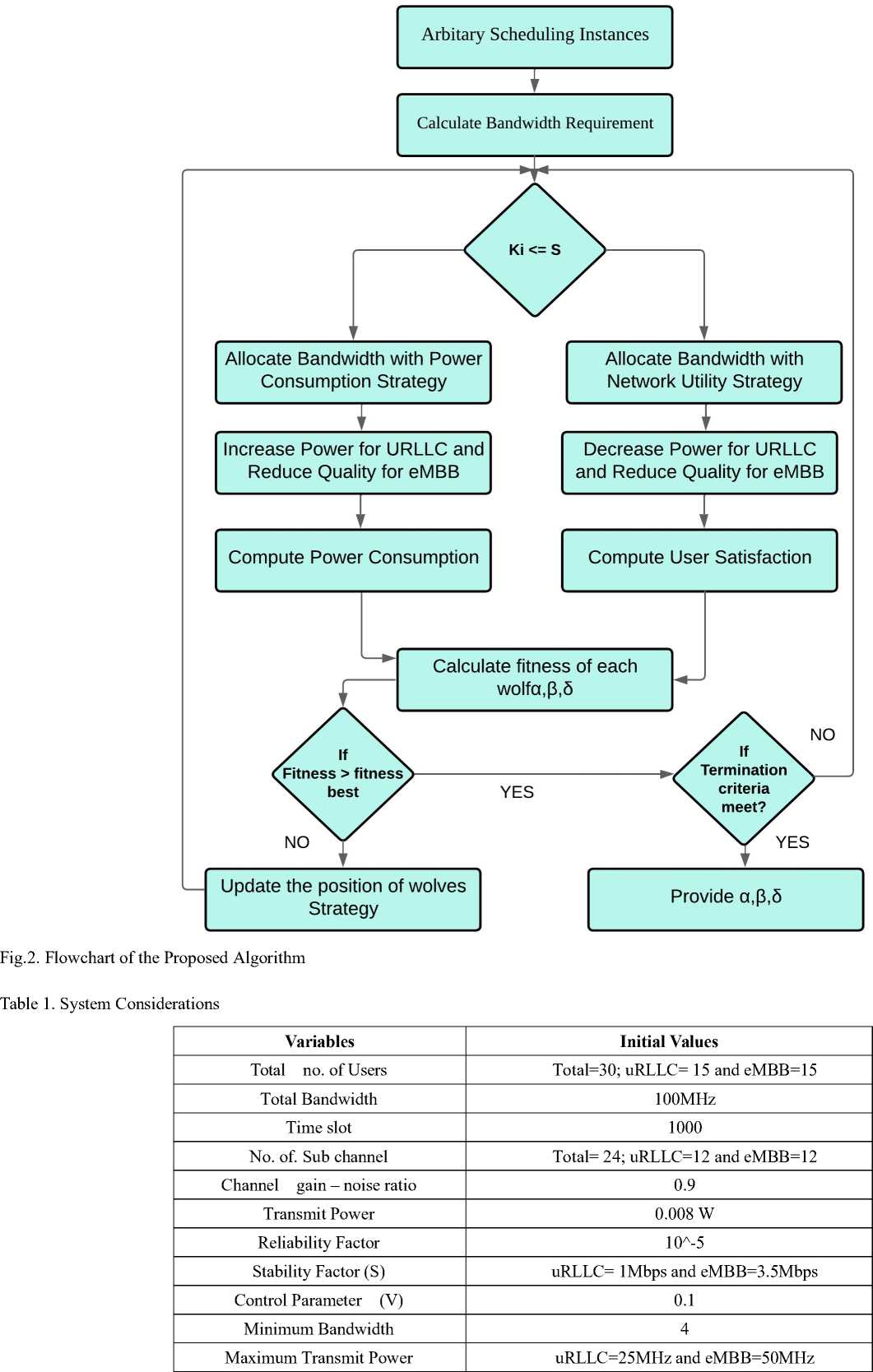
In fig.4 the experimentation was carried out for the varying value of V from 3 to 8. The user satisfaction declined for the V values from 3 to 4, but if observed the user satisfaction remains constant for the V values from 5 to 8. According to the results obtained by the proposed Algorithm with GWO we could gain average improvement of 27% than the DRA. From fig.2 and fig.3 the proposed algorithm proves that the balance between the power consumption and the user satisfaction is maintained with the improvement in the performance of the system. As the figure depicts the system gives better results for power consumption with the control variable from 5 to 8.
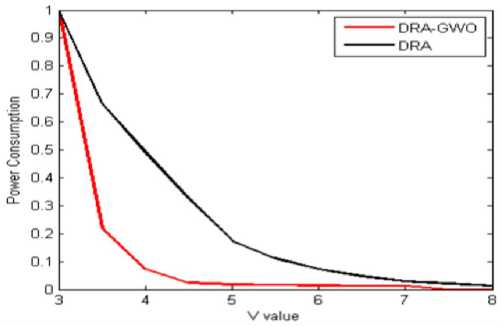
Fig.3. Power Consumption for uRLLC Services
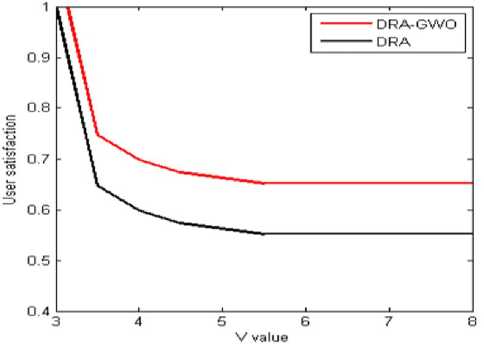
Fig.4. User Satisfaction for eMBB Services
Fig.5 shows the latency parameter for different timeslot varying from 100 to 1000. The proposed algorithm shows 32.51% improvement in the latency than the DRA with the constant value of V=4. These results prove that the proposed system works as latency sensitive for less value of control variable and power sensitive for higher values of V, wherein the user satisfaction is achieved to be constant the V values. Here, we have compared the results with the BSRA (Bandwidth Slicing and Resource Allocation) [17] and AGS (Alternative Concave Search) [24] algorithms, which were compared in [18]. Table 2 depicts the minimum value and maximum value of every algorithm for the proposed system which shows comparative minimum values than the proposed methods.
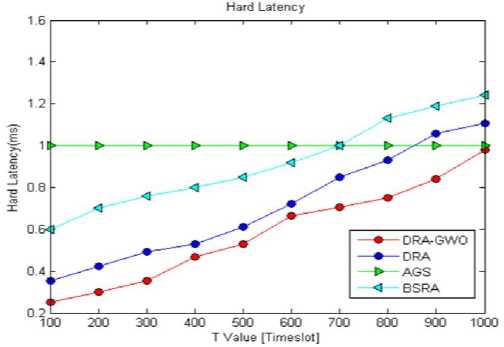
Fig.5. Latency
Table 2. Comparison of Latency in existing and proposed work
|
Algorithm Name |
Minimum range (ms) |
Maximum Range (ms) |
|
Alternative Concave Search Algorithm (ACS) |
1ms |
1ms |
|
Bandwidth Slicing and Resource Allocation Algorithm (BSRA) |
0.6ms |
1.2ms |
|
Dynamic Resource Allocation (DRA) |
0.4ms |
1.2ms |
|
Dynamic Resource Allocation Grey Wolf Optimization -DRA-GWO (Proposed Technology) |
0.22ms |
1ms |
5. Conclusions
This paper proposes a dynamic resource algorithm with Grey Wolf Optimization to the heterogeneous requirements in 5G RAN slicing technique. The proposed algorithm is a balancing algorithm between the power consumption and the user satisfaction along with improving the reliability of the system with latency for the uRLLC devices and the eMBB devices. To achieve this balance Lyapunov Function has been used where the control variable plays a major role to obtain the balance. A two-time scale comprising of long and short time scale has been used for the designing of the algorithm. Such system could greatly improve the resource allocation schemes with latency and energy constraints. GWO is used for optimization of resource allocation as it has an advantage of fewer parameters to control and simple principles. Since GWO also does not requires the derivative information in the search space and thus GWO based system is observed to be more sustainable approach than other algorithms. The proposed system shows significant improvement of 27% in user satisfaction and 17.5% improvement in power consumption. This system can be used for time critical applications like the industry 4.0, automatic surgery. This is also beneficial for rate critical applications like video streaming, high end video games, virtual reality etc. To further extend the work, the reinforcement learning approaches can be used for better resource allocation.
Список литературы Energy Efficient Resource Allocation in 5G RAN Slicing with Grey Wolf Optimization
- D. D. Lieira, M. S. Quessada, A. L. Cristiani and R. I. Meneguette, "Resource Allocation Technique for Edge Computing Using Grey Wolf Optimization Algorithm," 2020 IEEE Latin-American Conference on communications (LATINCOM), 2020, pp. 1-6, doi:10.1109/LATINCOM50620.2020.9282316.
- R. I. Meneguette, G. P. R. Filho, L. F. Bittencourt, J. Ueyama, B. Krishnamachari and L. A. Villas, "Enhancing intelligence in inter-vehicle communications to detect and reduce congestion in urban centers", 2015 IEEE ISCC, pp. 1-6, 2015.
- R. I. Meneguette, E. R. M. Madeira and L. F. Bittencourt, "Multi-network packet scheduling based on vehicular ad hoc network applications", 2012 8th international conference on network and service management (cnsm) and 2012 workshop on systems virtualiztion management (svm), pp. 214-218, 2012.
- T. X. Tran, A. Hajisami, P. Pandey and D. Pompili, "Collaborative mobile edge computing in 5g networks: New paradigms scenarios and challenges", IEEE Communications Magazine, pp. 54-61, 2017.
- T. X. Tran, A. Hajisami, P. Pandey and D. Pompili, "Collaborative mobile edge computing in 5g networks: New paradigms scenarios and challenges", IEEE Communications Magazine, pp. 54-61, 2017.
- I. Afolabi et al., “Network Slicing & Softwarization: A Survey on Principles, Enabling Technologies & Solutions,” IEEE Commun. Surveys & Tutorials, 2018, pp. 1–24.
- S. Ravindran, S. Chaudhuri, J. Bapat and D. Das, "EESO: Energy Efficient System-resource Optimization of Multi-Sub-Slice-Connected User in 5G RAN," 2020 IEEE International Conference on Electronics, Computing and Communication Technologies (CONECCT), 2020, pp. 1-6, doi: 10.1109/CONECCT50063.2020.9198455.
- Humar, I.; Ge, X.; Xiang, L.; Jo, M.; Chen, M.; Zhang, J. Rethinking energy efficiency models of cellular networks with embodied energy. IEEE Netw. 2011, 25, 40–49.
- Oh, E.; Son, K.; Krishnamachari, B. Dynamic base station switching-on/off strategies for green cellular networks. IEEE Trans.Wirel. Commun. 2013, 12, 2126–2136.
- Ulukus, S.; Yener, A.; Erkip, E.; Simeone, O.; Zorzi, M.; Grover, P.; Huang, K. Energy harvesting wireless communications: A review of recent advances. IEEE J. Sel. Areas Commun. 2015, 33, 360–380.
- Zappone, A.; Jorswieck, E. Energy efficiency in wireless networks via fractional programming theory. Found. Trends Commun. Inf. Theory 2015, 11, 185–396.
- Han, C.; Harrold, T.; Armour, S.; Krikidis, I.; Videv, S.; Grant, P.M.; Haas, H.; Thompson, J.S.; Ku, I.; Wang, C.X.; et al. Green radio:Radio techniques to enable energy-efficient wireless networks. IEEE Commun. Mag. 2011, 49, 46–54.
- Rost, P.; Bernardos, C.J.; De Domenico, A.; Di Girolamo, M.; Lalam, M.; Maeder, A.; Sabella, D.; Wübben, D. Cloud technologies for flexible 5G radio access networks. IEEE Commun. Mag. 2014, 52, 68–76.
- Kourtis, M.-A.; Sarlas, T.; Xilouris, G.; Batistatos, M.C.; Zarakovitis, C.C.; Chochliouros, I.P.;Koumaras, H. Conceptual Evaluation of a 5G Network Slicing Technique for Emergency Communications and Preliminary Estimate of Energy Trade-Off. Energies 2021,14,6876.https://doi.org/10.3390/en14216876.
- B. Matthiesen, O. Aydin and E. A. Jorswieck, "Throughput and Energy-Efficient Network Slicing," WSA 2018; 22nd International ITG Workshop on Smart Antennas, 2018, pp. 1-6.
- H. Wang, C. Liu, L. Shen, and W. Xia, ``Delay-aware resource allocation scheme for heterogeneous multi-radio access system based on Lyapunov optimization,'' in Proc. 10th Int. Conf. Commun. Netw. China (ChinaCom),Aug. 2015, pp. 32_36.
- J. Kwak, J. Moon, H.-W. Lee, and L. B. Le, ``Dynamic network slicing and resource allocation for heterogeneous wireless services,'' in Proc. IEEE 28th Annu. Int. Symp. Pers., Indoor, Mobile Radio Commun. (PIMRC),Oct. 2017, pp. 1_5.
- L. Feng, Y. Zi, W. Li, F. Zhou, P. Yu and M. Kadoch, "Dynamic Resource Allocation With RAN Slicing and Scheduling for uRLLC and eMBB Hybrid Services," in IEEE Access, vol. 8, pp. 34538-34551, 2020, doi: 10.1109/ACCESS.2020.2974812.
- S. K. Goudos, T. V. Yioultsis, A. D. Boursianis, K. E. Psannis and K. Siakavara, "Application of New Hybrid Jaya Grey Wolf Optimizer to Antenna Design for 5G Communications Systems," in IEEE Access, vol. 7, pp. 71061-71071, 2019, doi: 10.1109/ACCESS.2019.2919116.
- Huang, G., Cai, Y., Liu, J. et al. A Novel Hybrid Discrete Grey Wolf Optimizer Algorithm for Multi-UAV Path Planning. J Intell Robot Syst 103, 49 (2021).https://doi.org/10.1007/s10846-021 01490-3.
- Amruta Lipare, Damodar Reddy Edla, Venkatanareshbabu Kuppili,”Energy efficient load balancing approach for avoiding energy hole problem in WSN using Grey Wolf Optimizer with novel fitness function,”Applied Soft Computing,Volume 84,2019,105706,ISSN 15684946,https://doi.org/10.1016/j.asoc.2019.105706.
- S. Mirjalili, S. M.Mirjalili, and A. Lewis, “Grey wolf optimizer,''Adv. Eng. Softw., vol. 69, pp. 46_61, Mar. 2014. [Online]. Available:http://www.sciencedirect.com/science/article/pii/S0965997813001853.
- Y. Yao, L. Huang, A. Sharma, L. Golubchik, and M. Neely, ``Data centers power reduction: A two time scale approach for delay tolerant workloads,''in Proc. Proc. IEEE INFOCOM, Mar. 2012, pp. 1431_1439.
- H. Wang, C. Liu, L. Shen, and W. Xia, ``Delay-aware resource allocation scheme for heterogeneous multi-radio access system based on Lyapunov optimization,'' in Proc. 10th Int. Conf. Commun. Netw. China (ChinaCom),Aug. 2015, pp. 32_36.

